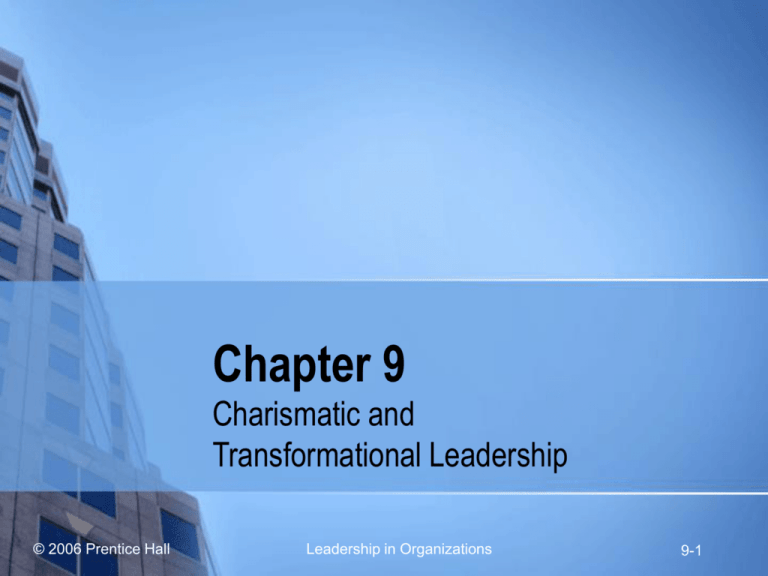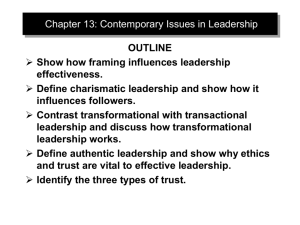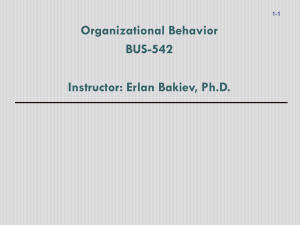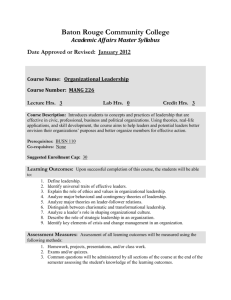Chapter 9
advertisement

Chapter 9 Charismatic and Transformational Leadership © 2006 Prentice Hall Leadership in Organizations 9-1 Learning Objectives Understand how the theories of charismatic and transformational leadership differ from earlier leadership theories Understand similarities and differences among the major theories of charismatic and transformational leadership Understand why attributions of charisma are jointly determined by the leader, the followers, and the situation Understand what traits, behaviors, and influence processes are involved in charismatic and transformational leadership © 2006 Prentice Hall Leadership in Organizations 9-2 Learning Objectives Understand why charismatic leadership can result in undesirable consequences for followers and the organization Understand what research methods have been used to evaluate theories of transformational and charismatic leadership Understand the major findings in empirical research on the effects of charismatic and transformational leadership Understand how to apply the theories to become more effective as a leader © 2006 Prentice Hall Leadership in Organizations 9-3 Early Theories Charisma Max Weber – Divinely inspired gift Occurs during a social crisis Leader emerges with a radical vision that offers a solution Transforming Leadership © 2006 Prentice Hall Burns’ book on political leadership Transforming leadership appeals to the moral values of followers to raise their consciousness and mobilize their energies Transactional leadership motivates followers by appealing to their self-interest and exchanging benefits Leadership in Organizations 9-4 Attribution Theory of Charismatic Leadership Leader Traits and Behaviors Influence Processes Advocate a vision highly discrepant from the status quo Acts in unconventional ways Make self-sacrifices Appear confident about their proposals Inspire them with emotional appeals See opportunities that others fail to recognize Personal identification Internalization Facilitating Conditions © 2006 Prentice Hall Follower disenchantment Crisis situation Leadership in Organizations 9-5 Self-Concept Theory of Charismatic Leadership Indicators of Charisma Leader Traits and Behaviors © 2006 Prentice Hall Articulating an appealing vision Using strong, expressive forms of communication when articulating the vision Taking personal risks and making self sacrifices to attain the vision Communicating high expectations Expressing confidence in followers Modeling behaviors consistent with the vision Managing follower impressions of the leader Building identification with the group or organization Empowering followers. Leadership in Organizations 9-6 Self-Concept Theory of Charismatic Leadership Influence Processes Personal identification Social identification Internalization Individual self-efficacy and collective efficacy Facilitating Conditions © 2006 Prentice Hall Leader’s vision is congruent with existing follower values and identities Task roles defined in ideological terms that appeal to followers Crisis situation Leadership in Organizations 9-7 Other Conceptions of Charisma Psychodynamic Processes Social Contagion and Charisma Close and Distant Charisma Routinization of Charisma © 2006 Prentice Hall Leadership in Organizations 9-8 © 2006 Prentice Hall Leadership in Organizations 9-9 Consequences of Charismatic Leadership Positive and Negative Charismatics © 2006 Prentice Hall Determined by examining the consequences for followers Negative charismatics have a personalized power orientation Positive charismatics have a socialized power orientation Leadership in Organizations 9-10 Consequences of Charismatic Leadership The Dark Side of Charisma Being in awe of the leader reduces good suggestions by followers Desire for leader acceptance inhibits criticism by followers Adoration by followers creates delusions of leader infallibility Excessive confidence and optimism blind the leader to real dangers Denial of problems and failures reduces organizational learning © 2006 Prentice Hall Leadership in Organizations 9-11 Consequences of Charismatic Leadership The Dark Side of Charisma Risky, grandiose projects are more likely to fail Taking complete credit for successes alienates some key followers Impulsive, nontraditional behavior creates enemies as well as believers Dependence on the leader inhibits development of competent successors Failure to develop successors creates an eventual leadership crisis © 2006 Prentice Hall Leadership in Organizations 9-12 Transformational Leadership Leader Behaviors Transformational Behaviors Transactional Behaviors © 2006 Prentice Hall Idealized influence Individualized consideration Inspirational motivation Intellectual stimulation Contingent reward Active management by exception Passive management by exception Leadership in Organizations 9-13 Transformational Leadership Influence Processes Transactional Leadership Transformational Leadership © 2006 Prentice Hall Instrumental compliance Internalization Personal identification Leadership in Organizations 9-14 Transformational Leadership Facilitating Conditions © 2006 Prentice Hall Some aspects of transformational leadership are relevant in most if not all situations Dynamic, unstable environment that increase the need for change Leaders are encouraged to be flexible and innovative Follower traits and values Leadership in Organizations 9-15 Research Methods for Assessing the Theories Survey Research Laboratory Experiments Field Experiments Descriptive and Comparative Studies Intensive Case Studies © 2006 Prentice Hall Leadership in Organizations 9-16 Transformational vs. Charismatic Leadership Differences and Similarities between the Theories Evaluation of the Theories Available evidence supports charismatic and transformational leadership theories Several of their propositions can be found in earlier theories – “Old wine in a new bottle” Conceptual weaknesses © 2006 Prentice Hall Ambiguous constructs Insufficient description of explanatory processes Narrow focus on dyadic processes Omission of some relevant behaviors Insufficient specification of situational variables Bias toward heroic conceptions of leadership Overemphasis on universal leader attributes that are not relevant for all situations Leadership in Organizations 9-17 Guidelines for Transformational Leadership Articulate a clear and appealing vision Explain how the vision can be attained Act confident and optimistic Express confidence in followers Use dramatic, symbolic actions to emphasize key values Lead by example © 2006 Prentice Hall Leadership in Organizations 9-18






